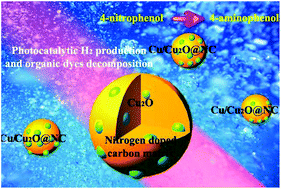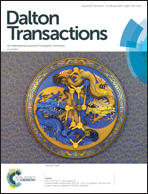Oxygen vacancy rich Cu2O based composite material with nitrogen doped carbon as matrix for photocatalytic H2 production and organic pollutant removal†
Abstract
A nitrogen doped carbon matrix supported Cu2O composite material (Cu/Cu2O@NC) was fabricated successfully with a coordination polymer as precursor through calcination. In this composite material, Cu2O particles with a size of about 6–10 nm were dispersed evenly in the nitrogen doped carbon matrix. After calcination, some coordinated nitrogen atoms were doped in the lattice of Cu2O and replace oxygen atoms, thus generating a large number of oxygen vacancies. In Cu/Cu2O@NC, the existence of oxygen vacancies has been confirmed by electron spin resonance (ESR) and X-ray photoelectron spectroscopy (XPS). Under visible light irradiation, Cu/Cu2O@NC exhibits excellent H2 production with the rate of 379.6 μmol h−1 g−1. Its photocatalytic activity affects organic dyes, such as Rhodamine B (RhB) and methyl orange (MO). In addition to photocatalysis, Cu/Cu2O@NC also exhibits striking catalytic activity in reductive conversion of 4-nitrophenol to 4-aminophenol with in presence of sodium borohydride (NaBH4). The conversion efficiency reaches almost 100% in 250 s with the quantity of Cu/Cu2O@NC as low as 5 mg. The outstanding H2 production and organic pollutants removal are attributed to the oxygen vacancy. We expect that Cu/Cu2O@NC will find its way as a new resource for hydrogen energy as well as a promising material in water purification.



 Please wait while we load your content...
Please wait while we load your content...